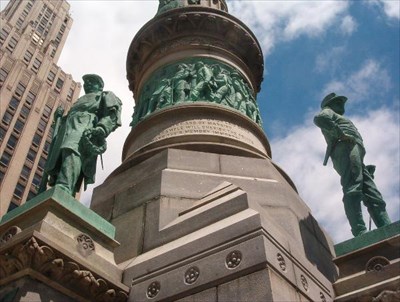
Soldiers & Sailors Monument - Buffalo, NY
Posted by:  Rayman
Rayman
N 42° 53.140 W 078° 52.434
17T E 673618 N 4750311
This Civil War monument is located in Lafayette Square, downtown Buffalo, NY.
Waymark Code: WMF19
Location: New York, United States
Date Posted: 06/16/2006
Views: 114

The first public meeting to discuss a Civil War monument for Lafayette Square was held on April 14, 1866, but nothing much got accomplished until the Ladies Union Monument Association was organized on July 2, 1874. The women soon raised $12,000 in subscriptions and approved the design submitted by architect George Kellar of Hartford CT. Compelled to take action during 1881 in view of the progress made by the ladies, the city government appropriated $45,000 for the project and awarded a construction contract to the Mount Waldo Granite Company of Bangor, Maine. Proposals for bronze sculptures (and the stone lady who topped the column) by Caspar Buberl were eventually approved. The corner stone was laid July 2, 1882 during a grand celebration which was attended by Buffalo mayor Grover Cleveland.
The completed monument was standing in Lafayette Square before the last day of 1883, but dedication ceremonies had been set for the following year. The features of the monument still appear today as they did in 1883: A nameless stone lady, "emblematic of Buffalo," sits atop the 85-foot column. Eight-foot statues representing members of the infantry, cavalry, artillery, and navy surround the shaft, which itself is decorated with bronze symbols of the nation and state, the seal of Buffalo, and a "drum" showing over thirty bas-relief figures. The final half of Lincoln's Gettysburg Address appears below the "drum" on the back of the monument and the message "in front," facing Main Street, dedicates it to those who laid down their lives "in the war to maintain the union for the cause of their country and of mankind." Chief among the bas-relief scenes on the "drum" is a view of Lincoln with his original cabinet. Also part of the bas-relief are soldiers marching in reply to Lincoln's call.
Grover Cleveland, now governor of New York, came back two years later to dedicate the monument.